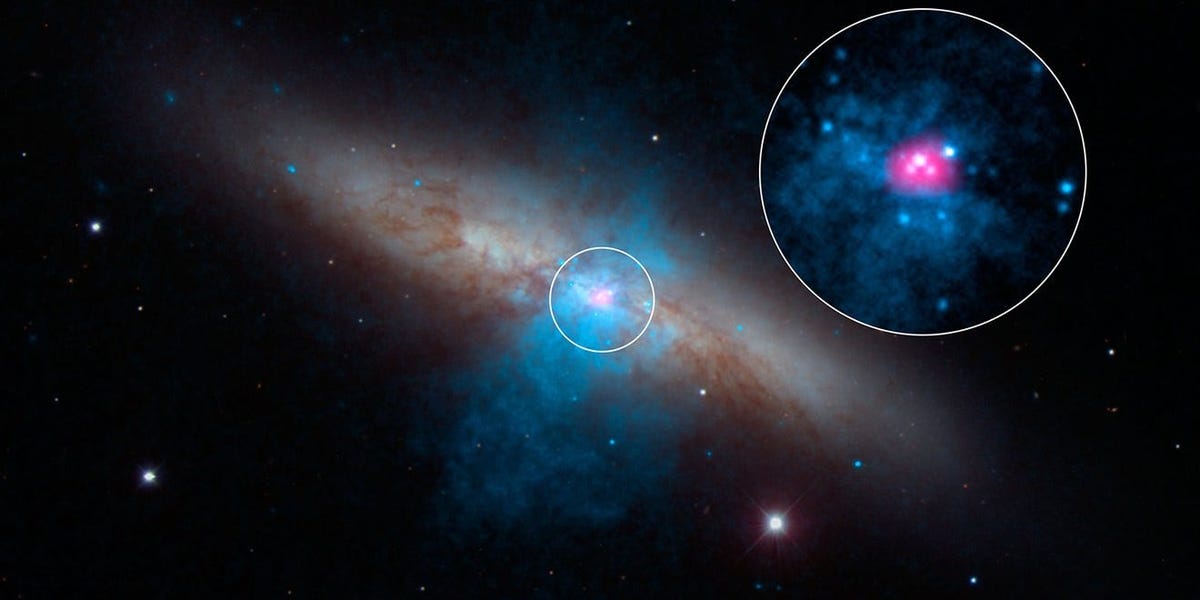- Ultraluminous X-ray sources are objects that shine 10 million times as brightly as the Sun.
- Scientists say they are too bright to exist because they break the Eddington limit.
- A new study confirms the brightness of ULX – the mystery of how it exists remains unsolved.
Scientists are baffled by a mysterious celestial object that physics dictates should explode.
NASA is using so-called ultraluminous X-ray sources, objects 10 million times brighter than the Sun, to understand how they work.
These objects are theoretically impossible because they break the Eddington limit, a law of astrophysics that requires an object to be too bright before it breaks apart.
The new study classifies ULX 12 million light-years away as M82 X-2 as bright as previous observations suggested.
But the question remains: how can it exist?
Shiny objects should push the object away
Photo montage showing the appearance of the galaxy Messier 82 in visible light, left, and X-ray light.
NASA/STScI/SAO
The principle behind Arthur Eddington’s regime is simple. The glow on this scale comes only from material — like star dust from the remnants of disintegrating planets — falling inward toward a massive object like a black hole or dead star.
As the object is pulled by its intense gravity, the object heats up and emits light. The material falling towards the object is more luminous. But there is a catch.
At a certain point, so much matter is pulled in that the radiation it emits is able to override the gravitational force from the massive object. That means at some point, the object’s radiation must push it away and stop it falling.
But if it doesn’t fall, the object must not be radiating, which means the object must not be luminous. Hence the Eddington limit.
The M82 X-2 is achieving the impossible
NASA observations show a pulsation of X-ray energy from M82 X-2.
NASA/JPL-Caltech
Because of the Eddington limit, scientists have questioned whether the ULX’s brightness is actually caused by the enormous amount of material falling into it.
One theory, for example, is that strong cosmic winds concentrate all matter into a cone. In this theory, the cone is pointed toward Earth, creating a beam of light that appears brighter than if the material were spread evenly around the ULX.
But a new study looking at M82 X-2 puts to rest the ULX, a cone theory caused by a pulsating neutron star in the Messier 82 galaxy.
(A neutron star is the superdense material left over when a star runs out of energy and dies.)
The analysis, published in April in The Astrophysical Journal, found that M82 X-2 has pulled about 9 billion trillion tons of material a year from the neighboring star, or about 1.5 times the mass of Earth, a NASA statement said.
That means the brightness of this ULX is caused by a limit-breaking amount of material.
Superstrong magnetic fields can force atoms into submission
In this description of the ULX, the hot gas is pulled onto the neutron star. Strong magnetic fields emanating from the star are shown in green.
NASA/JPL-Caltech
Given this information, another explanation is the leading theory to explain ULXs. And it’s even weirder.
In this theory, superstrong magnetic fields are emitted from a neutron star. These are so strong that they squeeze the atoms of matter falling into the star, changing the shape of these atoms from a sphere to a long string, a NASA statement said.
In this case, the radiation from these squished atoms would have a harder time pushing the matter away, explaining why so much matter can fall into the star without disintegrating.
The problem is that we will never be able to test this theory on Earth. These theoretical magnetic fields must be so strong that no magnet on Earth can reproduce them.
“That’s the beauty of astronomy. By observing the sky, we expand our ability to probe how the universe works. On the other hand, we can’t really set up experiments to get quick answers,” Matteo Bacchetti, study author and astrophysicist with Italy’s National Institute for Astrophysics’ Cagliari Observatory, said in a NASA statement. .
We have to wait for the universe to show us its secrets, he said.
#mysterious #object #million #times #brighter #Sun #identified #Scientists #figure #didnt #explode
